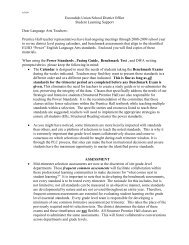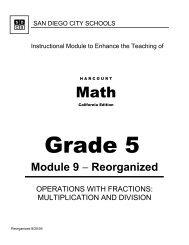Module 5 â Reorganized - eusddata
Module 5 â Reorganized - eusddata
Module 5 â Reorganized - eusddata
Create successful ePaper yourself
Turn your PDF publications into a flip-book with our unique Google optimized e-Paper software.
Harcourt Math−Grade 5 MODULE 5<br />
DAY 8<br />
UNIT 3: Multiply Whole Numbers and Decimals<br />
LESSON 10.4<br />
LESSON FOCUS:<br />
CALIFORNIA<br />
STANDARDS:<br />
PURPOSE OF<br />
LESSON:<br />
LAUNCH:<br />
Introduce students<br />
to concepts<br />
Thousand grids<br />
EXPLORE:<br />
Work with the<br />
concept. Focus on<br />
students “doing<br />
mathematics.”<br />
PRACTICE:<br />
Focus on<br />
Communication<br />
Place the Decimal Point<br />
Number Sense: 2.1<br />
Add, subtract, multiply, and divide with decimals; add with negative integers;<br />
subtract positive integers from negative integers; and verify the<br />
reasonableness of the results.<br />
Number Sense: 1.1<br />
Estimate, round, and manipulate very large and very small numbers.<br />
• To use estimation and patterns to place the decimal point.<br />
• To understand that to estimate, you round each decimal to the greatest<br />
place value, and multiply as with whole numbers.<br />
• Explore two strategies for estimating decimal products:<br />
Alternative Teaching Strategy, T.E. p. 164B (algorithm)<br />
Alternative Teaching Strategy, T.E. p. 166 (number line)<br />
• Connect the two strategies. Highlight the pattern of total number of<br />
decimal places in the factors is equal to the number of decimal places in<br />
the product.<br />
• Suggestion: Use the context below to practice strategies:<br />
“Sam used a calculator to do multiplication problems, but he forgot<br />
to put in the decimal point. His teacher says he needs to place the<br />
decimal point correctly in the problems.”<br />
How would you explain your strategy for correctly placing the decimal<br />
points?<br />
3.1 x 6.1 = 1891 3.2 x 4.5 = 1440 2.7 x 5.6 = 1512<br />
31 x 6,1 = 1891 32 x 4.5 = 1440 2.7 x 56 = 1512<br />
• Discuss the reasoning students used to place the decimal point. If<br />
estimation does not come up, ask how it could be used.<br />
• Ask the students to estimate and then find the exact product for 31 x 61.<br />
(Prompt students to notice that multiplying whole numbers results in the<br />
same digits in the product as multiplying with decimals.)<br />
• If students come up with the rule for counting decimal places, record it, and<br />
ask them to continue to test it out to see if they can eventually figure out a<br />
way to explain why it works.<br />
Books closed: Learn, p. 164. Put “Tip to Tip” on the board/overhead.<br />
Read with students.<br />
• Allow students to solve the problem and determine the placement of the<br />
decimal point. (connect to estimation strategy)<br />
• Remind students to estimate the product and place the decimal point<br />
where it makes sense.<br />
Practice & Problem Solving, p. 166 #50 – 55. Discuss.<br />
and Representation<br />
SUMMARIZE: T.E. ASSESS, p. 167: DISCUSS<br />
Connect purpose to T.E. ASSESS, p. 167: WRITE<br />
activities<br />
Assess Individually<br />
HOMEWORK: Mixed Review, p. 167<br />
Link Up to Reading, p. 167<br />
<strong>Reorganized</strong> 9/04/04 16






